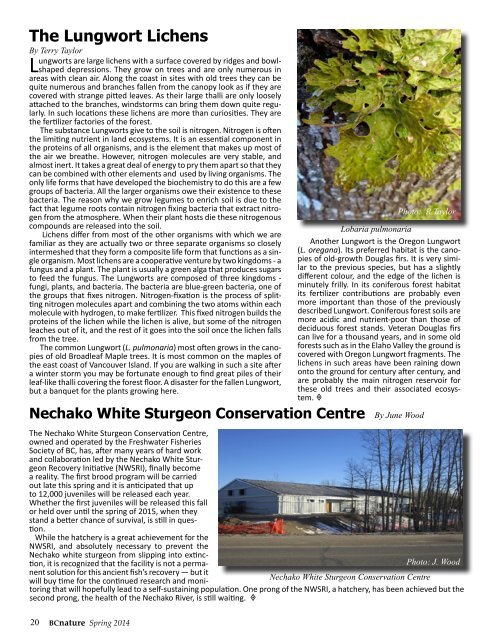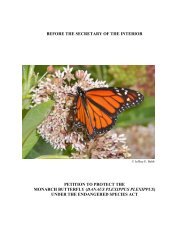BC-Nature-Spring-2014-web-final
BC-Nature-Spring-2014-web-final
BC-Nature-Spring-2014-web-final
Create successful ePaper yourself
Turn your PDF publications into a flip-book with our unique Google optimized e-Paper software.
The Lungwort Lichens<br />
By Terry Taylor<br />
Lungworts are large lichens with a surface covered by ridges and bowlshaped<br />
depressions. They grow on trees and are only numerous in<br />
areas with clean air. Along the coast in sites with old trees they can be<br />
quite numerous and branches fallen from the canopy look as if they are<br />
covered with strange pitted leaves. As their large thalli are only loosely<br />
attached to the branches, windstorms can bring them down quite regularly.<br />
In such locations these lichens are more than curiosities. They are<br />
the fertilizer factories of the forest.<br />
The substance Lungworts give to the soil is nitrogen. Nitrogen is often<br />
the limiting nutrient in land ecosystems. It is an essential component in<br />
the proteins of all organisms, and is the element that makes up most of<br />
the air we breathe. However, nitrogen molecules are very stable, and<br />
almost inert. It takes a great deal of energy to pry them apart so that they<br />
can be combined with other elements and used by living organisms. The<br />
only life forms that have developed the biochemistry to do this are a few<br />
groups of bacteria. All the larger organisms owe their existence to these<br />
bacteria. The reason why we grow legumes to enrich soil is due to the<br />
fact that legume roots contain nitrogen fixing bacteria that extract nitrogen<br />
from the atmosphere. When their plant hosts die these nitrogenous<br />
compounds are released into the soil.<br />
Lichens differ from most of the other organisms with which we are<br />
familiar as they are actually two or three separate organisms so closely<br />
intermeshed that they form a composite life form that functions as a single<br />
organism. Most lichens are a cooperative venture by two kingdoms - a<br />
fungus and a plant. The plant is usually a green alga that produces sugars<br />
to feed the fungus. The Lungworts are composed of three kingdoms -<br />
fungi, plants, and bacteria. The bacteria are blue-green bacteria, one of<br />
the groups that fixes nitrogen. Nitrogen-fixation is the process of splitting<br />
nitrogen molecules apart and combining the two atoms within each<br />
molecule with hydrogen, to make fertilizer. This fixed nitrogen builds the<br />
proteins of the lichen while the lichen is alive, but some of the nitrogen<br />
leaches out of it, and the rest of it goes into the soil once the lichen falls<br />
from the tree.<br />
The common Lungwort (L. pulmonaria) most often grows in the canopies<br />
of old Broadleaf Maple trees. It is most common on the maples of<br />
the east coast of Vancouver Island. If you are walking in such a site after<br />
a winter storm you may be fortunate enough to find great piles of their<br />
leaf-like thalli covering the forest floor. A disaster for the fallen Lungwort,<br />
but a banquet for the plants growing here.<br />
Nechako White Sturgeon Conservation Centre<br />
Photo: R.Taylor<br />
Lobaria pulmonaria<br />
Another Lungwort is the Oregon Lungwort<br />
(L. oregana). Its preferred habitat is the canopies<br />
of old-growth Douglas firs. It is very similar<br />
to the previous species, but has a slightly<br />
different colour, and the edge of the lichen is<br />
minutely frilly. In its coniferous forest habitat<br />
its fertilizer contributions are probably even<br />
more important than those of the previously<br />
described Lungwort. Coniferous forest soils are<br />
more acidic and nutrient-poor than those of<br />
deciduous forest stands. Veteran Douglas firs<br />
can live for a thousand years, and in some old<br />
forests such as in the Elaho Valley the ground is<br />
covered with Oregon Lungwort fragments. The<br />
lichens in such areas have been raining down<br />
onto the ground for century after century, and<br />
are probably the main nitrogen reservoir for<br />
these old trees and their associated ecosystem.<br />
<br />
By June Wood<br />
The Nechako White Sturgeon Conservation Centre,<br />
owned and operated by the Freshwater Fisheries<br />
Society of <strong>BC</strong>, has, after many years of hard work<br />
and collaboration led by the Nechako White Sturgeon<br />
Recovery Initiative (NWSRI), <strong>final</strong>ly become<br />
a reality. The first brood program will be carried<br />
out late this spring and it is anticipated that up<br />
to 12,000 juveniles will be released each year.<br />
Whether the first juveniles will be released this fall<br />
or held over until the spring of 2015, when they<br />
stand a better chance of survival, is still in question.<br />
While the hatchery is a great achievement for the<br />
NWSRI, and absolutely necessary to prevent the<br />
Nechako white sturgeon from slipping into extinction,<br />
it is recognized that the facility is not a permanent<br />
solution for this ancient fish’s recovery — but it<br />
Photo: J. Wood<br />
will buy time for the continued research and moni-<br />
Nechako White Sturgeon Conservation Centre<br />
toring that will hopefully lead to a self-sustaining population. One prong of the NWSRI, a hatchery, has been achieved but the<br />
second prong, the health of the Nechako River, is still waiting. <br />
20<br />
<strong>BC</strong>nature <strong>Spring</strong> <strong>2014</strong>




